|
FEATURES
PAGE 2 • ALL IN THE NUCLEAR FAMILY • SNOWY WHITE All In the Nuclear Family The 1977 Tour: Those Were the Inflatables by Dave Ward
Nearly every fan of Pink Floyd is aware of the famous inflatable flying pig which debuted during the 1977 tour for Animals and has remained with the band for every tour since. But the pig was only one of an entire family of inflatables used during the so-called "In the Flesh" tour of 1977. While the beloved pig has received many mentions and been the subject of a fair amount of attention by writers and fans, the "nuclear family" is rarely mentioned at all, and has never been examined in depth until now. The 1977 tour was not the first time Pink Floyd had used inflatables; not by any stretch. On 15 May 1971, Pink Floyd played the Crystal Palace Garden Party in London. At that show, during "Return of the Son of Nothing"—an early incarnation of the song later known as "Echoes"—while mist from dry ice swirled over the lake between the audience and the stage, a 50-foot inflatable octopus rose from the lake. A large spherical balloon—an inflatable moon—was floated over the stage during the 4 November 1973 show at the Rainbow Theater in London. Pictures of the moon were projected on its surface during the performance of Dark Side of the Moon. An inflatable pyramid was created for the Wish You Were Here tour by Jonathan Park (a rock concert set designer and engineer) and Mark Fisher (a rock concert set architect). The pyramid debuted at the 20 June 1975 concert at Three Rivers Stadium in Pittsburgh, Pennsylvania. Unfortunately the fragile pyramid tipped over and the balloon which caused it to rise escaped. The inflatable pyramid, originally intended to become a fixture during the tour, was abandoned. Although the first collaboration between Fisher and Park was ultimately a failure, it was the beginning of a long, successful partnership. Pink Floyd's next inflatable, the pig which appeared on the cover of Animals, was 30 feet long by 20 feet high. The benign caucasian-colored pig was designed in December 1976 by Jeffrey Shaw of the Eventstructure Research Group (E.R.G.) in Amsterdam, the Netherlands. The famous story of its escape and later recovery doesn't need to be retold here.
Pink Floyd wanted to use inflatables during their 1977 Animals tour. After its rescue from a farmer's field, the pig used in the cover shoot for Animals was used for a few publicity events and then retired. But the pattern for the pig was used to create several new pigs. Those pigs, which had a nastier expression on their face than the benignly smiling pig who graced the album cover, were taken along for the 1977 tour of Europe and Britain. A cable up to 1500 feet long was run from the back of the audience, above the audience's heads, to a crane behind the center of the stage. One of the enormous pig balloons would be hidden behind the stage ahead of time. During "Pigs (Three Different Ones)" the pig would slide down the cable to float above the audience, and then return to its hiding place at the stage. Once out of view, a second pig—this one a cheaper disposable version loaded with highly combustable helium and propane—would rise over the stage, and then be exploded 330 feet overhead. An inflatable pig might have been enough for David Gilmour, Nick Mason and Rick Wright, but Roger Waters wanted to add more inflatables for the American leg of the tour. "Actually, I think the 'boys' thought I'd gone the way of Syd when I said that we needed a giant inflatable family and a load of inflatable animals," Waters said in a 1987 interview. Waters asked Aubrey Powell of the Hipgnosis design team to find somebody to design additional inflatables. Powell contacted Andrew Sanders, who was highly regarded as a creator of wax figures. Sanders accepted the job, and then contacted the doorman at London's Palace Theatre. The doorman recommended Mark Fisher. Fisher was already known to Pink Floyd for his work on the inflatable pyramid two years earlier, so Fisher returned to work with Pink Floyd again, bringing along Jonathan Park to help with the rigging and controls. Fisher and Park would also accompany the Floyd on their North American tour from Miami to Montreal. Waters' idea was to have a life-size inflatable "nuclear family" above the stage during the song "Dogs." He wanted the family to consist of a businessman, his wife and, to be statistically accurate, two and a half children. To represent consumerism, he also wanted to have an inflatable television, a refrigerator which could open to spill out inflatable worms, and two cars: a Cadillac and a Volkswagon Beetle. The family debuted on 15 March 1977 in London, but the additional figures of the television, refrigerator and car didn't debut until the North American tour began in Miami on 22 April.
Waters wanted all the inflatables to be life-size, but Fisher felt that they should be huge to be visible and impressive from any seat in the large stadiums the Floyd were going to be playing during the tour. The disagreement eventually reached a compromise. Waters and Fisher agreed the figures would be three times life size. Fisher stll felt they should be larger and Waters felt they should be life-size, but the agreement stood. Fisher and Sanders created styrofoam miniatures of the inflatables. They made miniature tissue paper patterns for the cloth pieces, then enlarged these patterns with an overhead projector. Rob Harries, who later would help construct the enormous pig for Waters' 1990 Berlin concert, sewed the cloth patterns to form the full-size inflatables while Park prepared the industrial fans, cables and hydraulic cranes which would inflate the figures and then move them over the stage. A few inflatables Waters wanted were never used in concert, notably the VW Beetle. Perhaps Volkswagon objected. Or maybe only a certain number of inflatables could be managed. Or perhaps there was some other reason. Unfortunately, the reason for the failure of the inflatable Beetle appears to be unknown today. Each figure was constructed of a heavy translucent plastic and was painted. Each was internally lit by several bulbs placed inside the figures.
The businessman/father wore red-and-navy "pinstriped" pants and vest over a white shirt with blue pinstripes. Each pinstripe was actually about eight inches wide so they could be seen across the entire stadium. He also had a mustache and wore glasses, and carried a cigar in his left hand. His portly wife was seated on a red couch. She had a rather small head with painted-on long blonde hair. Their son wore red overalls with a blue and white striped shirt. He also wore a blue and white striped cap and blue socks. The daughter and the statistical "half-a-child" were fused together, permanantly holding hands. The daughter wore a red dress with a white collar and red stockings. Her blonde hair stuck out as a cone on each side of her head, perhaps representing pigtails, or some other experimental hairdo a young girl might wear. The half-child consisted only of his right side, and wore a shirt with light and dark blue stripes, a pale blue diaper and blue socks. The giant pink Cadillac appears to be a late-50s model with enormous fins at the back. It had clearly-formed wheels, bumper and grille, as well as a dark roof with white painted windows. The television was blue with four legs, a silver-painted screen, and two white antennae which usually tended to droop down on top of the set. The refrigerator was white, with the word "Floyd" and a crown logo in blue on the front of the closed door. The refrigerator even came with a white, inflatable electrical plug. All together, the inflatables were a visual reinforcement of the theme of the song "Dogs." The business man was the "dog" with all his materialism, backstabbing and selfishness. His portly family and their car and appliances represented the consumerism and materialism which Waters was criticizing in the lyrics.
A hydraulic crane was set at each side of the Animals tour stage. A pair of parallel cables was stretched from right to left over the stage, from one crane to the other. The cables suspended two horizontal poles which in turn held the inflatables. The combination of the cables for the family running left to right, with the cable for the inflatable pig running from behind center stage to above the audience, now formed a "T" shape of cables over the stage and audience. At the concerts, the inflatables were stored in large crates on the side of the stage. As Pink Floyd began to play "Dogs," the inflatable family would begin to come to life at the side of the stage. The road crew turned on several massive industrial fans which would quickly inflate several of the figures at a time.Winches in Jonathan Park's rigging would quickly raise each inflated figure into position above the stage as the Floyds performed. Unlike the other inflatables, the father was suspended from a travelling winch. He would be flown directly over center stage. When the refrigerator was raised, its door would initially be closed. But once in position, the door would be opened by remote control, and several inflatable worms would spill out. The worms were pink with blue bands to indicate sections. The worms represented decay, and served as a reminder that this isn't a cute, sweet family, but rather that they're rotting and decaying inside because of their consumerism and selfishness. During the final verse, the businessman would be intentionally deflated before the audience's eyes, and would drift down like a crumpled rag to be retrieved by the stage hands. The Montreal concert of 6 July marked the end of the 1977 tour and the end of the inflatable nuclear family, which thereafter would be put in storage and would, to the likely disappointment of many fans, be left to decay until they were useless. But the concepts behind several of the 1977 nuclear family balloons would become integral parts of The Wall. The television became an important part of the plot of The Wall, representing the emptiness in Pink's life and his tendency to forfeit control of himself. And the worms which sprung from the refrigerator to remind us of the family's inner decay became even better remembered as a symbol of Pink's rotting mind in The Wall.
The nuclear family itself, though little-known and largely ignored, has not be entirely forgotten. During Waters' 1999-2000 tour, slides of the inflated family were projected behind the band during "Dogs," and a two-page spread in the tourbooks was devoted to pictures of the family.
And, of course, the pig which first sailed between the stacks of Battersea Power Station and then haunted the audience during "Pigs (Three Different Ones)" lives on as a visual icon at Pink Floyd and Roger Waters concerts even now. The pig appeared at Waters' Berlin concert in 1990, a pair of them showed up at all the 1994 Pink Floyd shows, and the pig was most recently used in the program and promotional materials for Roger Waters 1999-2000 tours. Bibliography:
Dave Ward ran the Pink Floyd news service The Steel Breeze from 1996 until 1999. Although he now devotes his free time largely to projects about the Canadian band Rush, he remains very active in the Pink Floyd online community. Several
Species of Animals Gathered Together on a Stage and Grooving with... Snowy White By Mike McInnis
Born in England in March 1948, White made his name playing with the likes of Peter Green and Al "Year of the Cat" Stewart. Toward the end of 1976, word got around that Pink Floyd was looking for a second guitarist for their touring band, and White was one of the few people that the Floyd actively pursued. Floyd manager Steve O'Rourke had been unsuccessful in reaching White through his manager, and eventually made contact through Kate Bush's manager, who lived down the street. White visited the Floyd while they were putting some of the finishing touches on Animals at Britannia Row Studios. As a sort of audition, Roger Waters had him play a solo which formed the bridge between the first and second verses of "Pigs on the Wing". Although the melodic solo is similar to David Gilmour's style, the discerning listener can easily tell differences in execution. But due to the constraints of the vinyl format, Waters and the Floyd decided to split the verses and put one on each side of the record, thus eliminating White's lone contribution to the recorded Pink Floyd canon. But this guitar solo did make an appearance on the then-popular 8-track format, bridging the two verses as originally intended. That was the only "official" release of the track, although collectors have seen to it that the song was released on various bootleg compilations. And in 1995, White himself released an official retrospective album entitled Gold Top that included the complete "Pigs on the Wing", solo and all. White's job as the second guitarist on the In the Flesh tour provided an ample opportunity to showcase his musical skill. The Floyds had, by this point in their careers, learned how to use the studio to their advantage, with layers upon layers of overdubs. To even begin to recreate this complex sound on stage, they needed someone to play additional lead guitar parts (such as the lead guitar duet in "Dogs"), someone to play rhythm parts while Gilmour played lead (such as in "Wish You Were Here"), and even someone to cover the bass solos that Gilmour had played in the studio (in "Pigs (3 Different Ones)"). These duties fell upon Snowy White. "With the Animals tour it was interesting because I played bass a lot of the time in the first half," White recalled to interviewer Ed Sander. "I used to walk on stage on my own and start the show with this bass thing and then the others used to walk on." He also reprised his forgotten "Pigs on the Wing" guitar solo, and played some lead on "Have a Cigar".
"Then in the second half of the show... sometimes I'd play the odd bit of harmony with Dave, sometimes rhythm, sometimes lead. Then towards the end it got a bit more freer and Dave and I would swap licks and things... "Shine On You Crazy Diamond" I used to be able to let fly a little bit on that. There was a certain amount of freedom and I think I managed to keep my own sound through most of it." And on the tour's final night in Montreal, White got a special chance to shine. The crowd was especially unruly, and Waters had become so angry that he spat on a fan. By the end of the concert, Gilmour was so disgusted and frustrated that he refused to perform the encores, choosing instead to stroll unnoticed through the crowd to the mixing booth and listen to the rest of the show from there. Wanting to end the performance on a somewhat upbeat note, Waters announced that the band was going to "play some music to go home to", and they improvised a slow blues, with White taking the lead guitar responsibilities. In many ways, the Animals tour marked the beginning of the end for the classic Pink Floyd lineup. Yet it marked only the beginning of Snowy White's long association with the band. Shortly after the Animals tour, he joined Richard Wright in the south of France to record the keyboardist's Wet Dream album (from which comes another track found on the Gold Top compilation, "Drop in From the Top"). He was also a member of the Surrogate Band that backed up the Floyds on the 1980 Wall shows in Los Angeles, New York, and London, taking a solo spotlight during "Another Brick in the Wall, part 2". White worked on demos for Waters' Radio KAOS and Amused to Death albums, but not on the albums themselves (although he did appear in the "What God Wants" video, miming Jeff Beck's guitar parts.) White performed as a member of the Bleeding Heart Band in Waters' 1990 staging of The Wall in Berlin (taking Gilmour's place atop the wall) and the 1991 Guitar Legends Festival in Seville, Spain. He was also a last-minute addition to the touring band for Waters' 1999 "In the Flesh" tour of the United States (and he toured with Waters in 2000 as well). White maintains ties to the David Gilmour faction as well. He has appeared at pubs with Gilmour, playing R&B covers with the Edgar Broughton Band, Paul Jones, and Tom Newman. Gilmour performed on White's Highway to the Sun album on a song called "Love, Pain, and Sorrow", also found on the Gold Top compilation.
Mike McInnis is a staff writer for Spare Bricks. He is deeply indebted to Snowy White and Floyd fan Ed Sander, whose assistance made this article possible. |

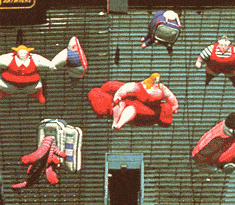

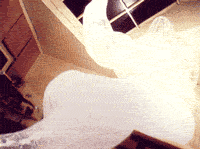
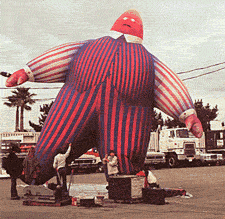
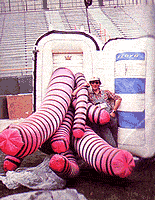
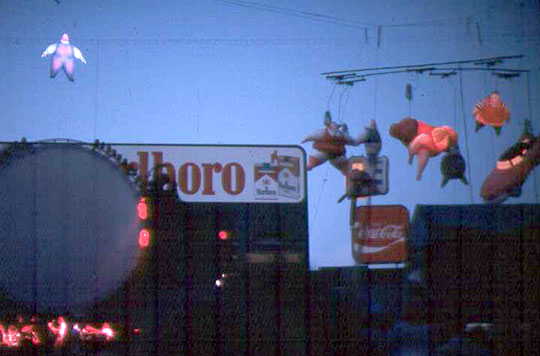
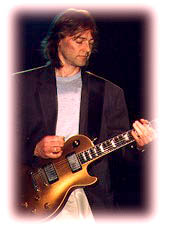 Nowadays,
it seems, it takes at least a dozen musicians to make a Floyd show sound
like a Floyd show. Even Roger Waters' solo band is a little on the bloated
side. But back when the Floyds first started to augment their touring
ensemble beyond a saxophonist and some female backup singers, all those
extra parts were handled by just one guy--Snowy White.
Nowadays,
it seems, it takes at least a dozen musicians to make a Floyd show sound
like a Floyd show. Even Roger Waters' solo band is a little on the bloated
side. But back when the Floyds first started to augment their touring
ensemble beyond a saxophonist and some female backup singers, all those
extra parts were handled by just one guy--Snowy White.